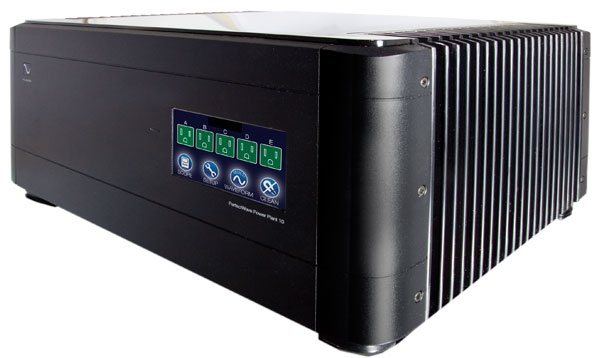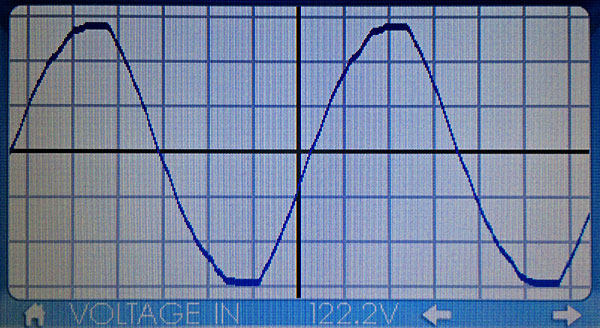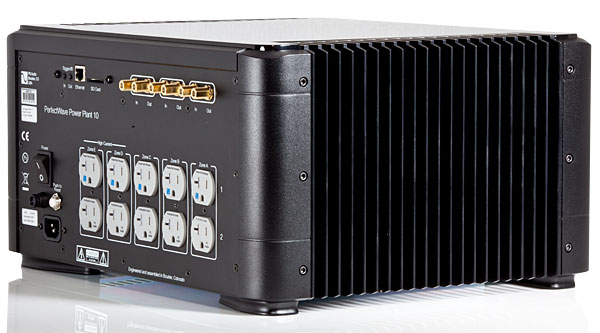PS Audio Perfectwave 10 Power Regenerator & Cables
R58,000.00
PS Audio PerfectWave P10 Power Plant AC Regenerator

Power conditioners can be as simple as chokes: big chunks of magnetic stuff, usually ferrous metal, wrapped around your wire (or vice versa), and acting as inductors—and, hence, as low-pass filters, to remove high-frequency noise from the AC. Other, similarly passive power-treatment devices use fancier new materials and more sophisticated technologies, but PS Audio advises its customers not to put all their trust in AC power filters. They write, in the NuWave DSD’s manual, that such devices may “‘bleach’ the sound and rob the music of life and dynamics.” They should know: Their first power-treatment product, which went on sale 35 years ago, was an isolation transformer—itself a passive device.Not everyone agrees that passive power conditioners degrade the sound, but the opinion can be defended on technical grounds: low-pass filters limit how fast current can flow—that’s what low-pass filtering means in the time domain—which means that they also limit how fast power-supply capacitors can recharge. (Whether that limitation is enough to affect the sound is, of course, a different question.) Another problem with power filters is that they can’t add back what’s missing—eg, the top few volts shaved from the sinewave that comes in through my wall (fig.1): a consequence of the overwhelming demand from all the other consumers and businesses with which my home shares the power company’s transformer (footnote 1). If the peaks of the incoming waveform are missing, the power-supply capacitors in my system may not get sufficient power when they need most to recharge.

PS Audio’s solution is to start from scratch: take the power coming in through the wall, rectify it, store it, regulate it, use it to generate a new and better AC signal, and then send it out (with usefully low impedance). Think of it as a highly specialized source component that outputs just one frequency, combined with a powerful amplifier. As long as your devices don’t crave more power than the Power Plant can deliver—1500VA (footnote 2) peak, 1200VA continuous—it should be a near-perfect solution to the problem of crappy power, assuming crappy power is a problem that needs solving.
And that’s the key question: Is such a device actually necessary? The PerfectWave P10 Power Plant does what it says it does: It outputs a clean, high-power sinewave that’s presumably of better quality than the one that comes from the power company. But for decades now, audio companies and designers have been dealing with tired, polluted sinewaves by incorporating into their products sophisticated, highly regulated power supplies. Indeed, the NuWave DSD DAC, which I was reviewing when PS Audio sent me the P10 Power Plant, boasts seven stages of regulation. Shouldn’t that be enough?
It’s true that the challenge for designers has increased over time. Especially in cities, circuits have become more crowded. With excess use and neglect, the electrical infrastructure has deteriorated—just like bridges and highways—and has not kept up with changes in technology. And now that wireless devices and cheap switching power supplies have become ubiquitous, there’s a lot more high-frequency hash on our power lines than there used to be. But then, that stuff is so far above 60Hz that it should be possible to filter it out without doing audible harm. Do I really need to spend another $5000 to get the most out of my fancy high-end gear?
Auld lang sine
Two paragraphs ago, I wrote that the P10 outputs a sinewave. But that’s not the only wave it puts out. The Power Plants—in addition to the P10, PS Audio sells the P5 ($3499, 1200VA) and the P3 ($2499, 750VA)—also output what the company calls MultiWave. PS Audio released their first regenerator, the P300, in 1997, and soon added a feature that made it possible for the user to adjust frequency, and to enjoy the performance differences that came about as a result: Is the bass more authoritative? Are the highs clearer? Is that smoke I smell?
Playing around with different waveforms, PS Audio’s engineers heard differences, sometimes for the better, sometimes for the worse, usually with tradeoffs. Eventually, they settled on one approach: a modified waveform with a wider peak than a sinewave has. PSA says this waveform recharges power-supply capacitors more effectively than a standard sinewave, which makes sense: The waveform is at or near its highest for more of the cycle. In the P10 and P5 Power Plants, MultiWave is available in six strengths, with each progressive step correlating with increased capacitor-charging time (and thus decreased power-supply ripple); the P3 Power Plant offers just one MultiWave setting.
The P10 is extremely heavy—73 lbs—and it looks impressive in its black finish (silver is also available). It has 10 outlets in five separately regenerated zones—enough to support a complex audio and/or audiovisual system. Two pairs of outlets are labeled High Current; these are the same as the others, except that, when first turned on, they limit the inrush of power to power-hungry components, which is gentler on your devices and on your house or apartment’s circuit breakers. In addition to MultiWave, there’s a CleanWave output setting that you can use to degauss the transformers in your audio system.

An RJ45 socket on the rear panel allows Ethernet connectivity to a home network and, ultimately, the Internet. This doesn’t enhance the P10’s sonic performance, but does offer a number of control and convenience options: you can gather power-consumption and performance-tracking records, remotely schedule the P10 to turn on and to warm up before you get home from work, and assign names to individual zones and outlets. If you’d rather not bother with all that, you can make adjustments—and monitor your incoming and outgoing waveforms, complete with a ‘scope-trace graphic and distortion stats—via the color touchscreen on the front panel.
Footnote 1: I’m oversimplifying a bit. Out-of-phase harmonics can reduce the peak amplitude of a waveform, and when that happens, filtering out those harmonics can improve the waveform’s shape. That’s not common, though, and in any event, it doesn’t change the basic fact that you can’t use a filter to restore missing energy.Footnote 2: Volt-amps and watts are usually about the same, but occasionally, current and voltage get out of phase. When that happens, the actual power delivered to a device—the actual wattage—may be somewhat less than the product of volts times amps.
Listening
When the PerfectWave P10 Power Plant was feeding my entire system, based on DeVore Fidelity The Nine loudspeakers and including a Leben CS-600 amplifier and analog and digital sources, I experienced exceptional musical moments more often, finding myself sitting up and taking notice of some musical detail. Streaming the Tidal playlist “Wildwood Flower: Best New Folk and Americana” at CD resolution, I was startled by the creaminess of Dori Freeman’s voice in “Where I Stood,” from her eponymous first album (CD, Free Dirt DIRTCD 0074). The percussiveness of Kristin Fossheim’s fortepiano was visceral in the first movement of Beethoven’s Sonata for Cello and Piano 2 in G, Op.5 No.2, and Bjørn Solum’s cello had a pleasant buzz (24-bit/96kHz download, 2L 79). When, on a low note (as at 2:32), the cello’s body resonated strongly, the room shook; could this be the “better bass” that PS Audio says on its website that I should expect? Of course, the P10 doesn’t get all the credit—it’s on the recording, and it takes a whole system to reproduce it—but it was less impressive with my system plugged straight into the wall.
Similarly, in the opening measures of Johan Kvandal’s Fantasy for Clarinet, Op.68 No.2, also on 2L (SACD/CD, 2L 55)—a Meridian Master Quality Authenticated recording played through a non-MQA DAC, which means, according to Meridian, that it should sound a bit better than a CD—the close-miked clarinet had exceptional body. And when an early, large crescendo challenged clarinetist Fredrik Fors’s dynamic range, his sound broke up in a way that’s familiar to me (I’ve heard that sound live, from good seats), but that rarely comes across from recordings—at least not with such humanity. The P10 consistently helped bring out music’s varied textures so that I was more actively engaged in it. It was hard not to listen.
There’s evidence that the quality of AC power is especially important in digital audio. In his review of AudioQuest’s JitterBug USB noise filter ($49) in the September 2015 issue, JA related what happened when his computer broke and he began listening to CDs again with his Ayre Acoustics C-5xeMP universal player: “Every disc I played sounded more solid, more corporeal than I remembered from the many times I’d played the same tracks from the Mac mini. The low frequencies sounded more authoritative, much as they had when I bought a Mark Levinson No.31 CD transport (now long since retired with mechanical problems).” With the JitterBug—a purely passive device that conditions a component’s USB outputs—JA found that music from his Mac mini sounded much more like what he’d experienced with the Ayre: “The low frequencies acquired more of the authority I experience with CDs.”
I heard the same thing in my home, with my system plugged into the P10: more authority in the low frequencies. JA’s observation (and mine) illustrates the importance of power—the height of waveforms, not just their timing—for digital sources, which is where I’ve noticed the most improvement with the P10 (footnote 3). I’ve already mentioned the Power Plant’s effect on music’s textures, and the increased bass authority; with the P10 in the system, I also found that the aural images reproduced from digital sources—specifically, PS Audio’s NuWave DSD, and their DirectStream DAC, which I borrowed from JA—were also fleshier, more corporeal, and better located in space. The sound with the P10 also seemed more natural and less electronic—almost suggesting a physical rather than electronic playback medium. As I wrote in the review of the NuWave DSD, a wood block sounded like a wood block, not a recording of a wood block.
Conclusions
In this age of improving power supplies, is a device like the PerfectWave P10 Power Plant necessary? That will depend on the quality of your incoming AC, something that varies from region to region (footnote 4). My apartment building is small by Manhattan standards—just 25 apartments—but it’s attached to similar buildings on right and left, with another one just behind. Right now, my MacBook Pro detects 33 wireless networks. Then there are the dimmer switches, switching power supplies, and cheap electronic transformers attached to low-voltage lights. All of those things affect my power supply—and this summer, the more than 30 window air conditioners in my building will suck even more energy from my AC.
Even as I write this, in March—still in heating season!—the P10’s built-in ‘scope tells me that the power coming out of my wall has 4–5% total harmonic distortion. The result is a dejected-looking wave more sawtooth than sine: it looks as if it’s about to break. To mix metaphors, its peaks are like erstwhile mountains in West Virginia coal country (speaking of decrepit power infrastructure). Again, the reason this happens is the reason it matters: The peak of the household-AC waveform corresponds to the point where the capacitors in the power supplies of my audio components recharge. Chop off that peak, and the power supplies in my gear are starved at least a little bit, even when the available power seems ample.
It’s not surprising that such a dejected-looking sinewave could suck the joy out of music. I knew it was possible that fixing my power would make my music cleaner and more accurate. What I didn’t anticipate was that it would make the music so much more engaging. Maybe more accurate is more engaging—an appealing thought. Anyway, the PerfectWave P10 Power Plant may be an essential accessory for any audiophile who lives in a neighborhood like mine. A power conditioner—sorry, regenerator—may not be a sexy purchase, but I’m going to have a hard time sending this thing back.
But, again—it depends. If you live in a quiet valley with a little stream running through it, and your house is served by its own private transformer, you may not need a power regenerator to get the kind of sound I’m getting with the P10. (I lived in a place like that for some 10 years; unfortunately, the acoustics sucked.) If you live in the US, PS Audio makes it easy to find out: You can audition a PerfectWave P10 Power Plant—or any of the other components for sale on their website—risk-free via PSA’s home-trial program.
Description
Screen has lines…doesnt affect reading and 100% working.
This includes:
5 x 1m PS Audio Punch& Prelude
1 x 5m Figure 8
1 x 2m PS Audio Punch& Prelude

Description: Regulated AC regenerator with 10 outputs and multiple output waveforms.
Load capability: 1500VA peak, 1200VA continuous.
Output impedance: <0.015 ohms.
Distortion on output wave: <0.5% into resistive and reactive loads.
Dimensions: 17″ (430mm) W by 14″ (360mm) D by 8.5″ (215mm) H.
Weight: 73 lbs (33kg).
Shipping weight: 82 lbs (38kg).















